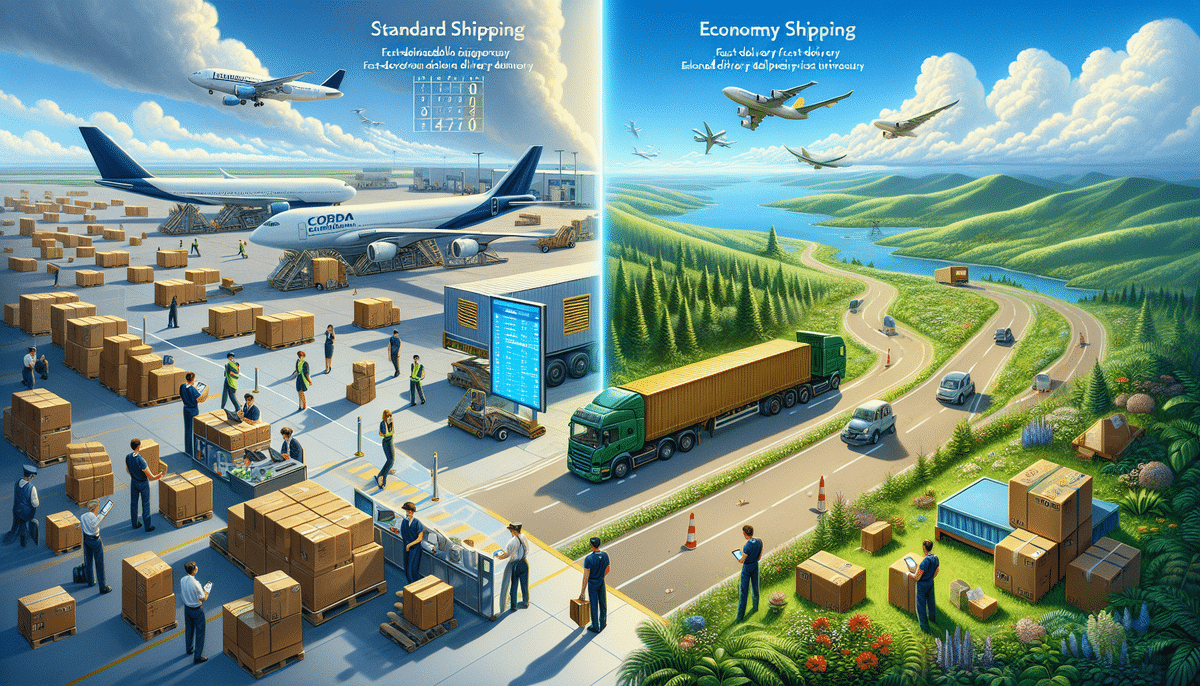Understanding Standard vs. Economy Shipping: Making the Right Choice for Your Needs
When selecting a shipping option for your packages, the decision often boils down to two primary choices: standard shipping and economy shipping. Each option offers distinct advantages and potential drawbacks, making it crucial to understand their differences to choose the best fit for your specific requirements. This comprehensive guide explores both standard and economy shipping in detail, providing insights to help you make an informed decision.
How Standard Shipping Works
Standard shipping is the most commonly utilized shipping method, offered by the majority of shipping carriers. Typically, standard shipping guarantees a delivery timeframe of three to five business days, though this can vary based on the carrier and the destination.
Packages sent via standard shipping are usually transported by a combination of trucks and planes, allowing for quicker delivery compared to other methods. This efficiency is achieved by consolidating packages heading in similar directions, which helps keep costs lower for consumers.
It’s important to note that standard shipping often does not include additional services such as signature confirmation or insurance. These can be added for an extra fee if needed. While reliable, standard shipping can still face delays or issues, so tracking your package is recommended to stay informed about its delivery status.
How Economy Shipping Works
Economy shipping is designed to be a cost-effective alternative to standard shipping, typically taking longer to deliver—ranging from five to ten business days depending on the carrier and destination.
This shipping method primarily relies on ground transportation, which is slower but more affordable than air transport. By minimizing transportation costs, carriers can offer lower rates to customers. Additionally, economy shipping often involves grouping packages bound for the same region, further reducing expenses.
An added benefit of economy shipping is its potential environmental friendliness. Ground transportation generally consumes less fuel and produces fewer carbon emissions compared to air shipping, making it a preferable choice for environmentally conscious individuals.
However, economy shipping may not be suitable for time-sensitive or high-value items due to its longer delivery times and limited tracking options. For such packages, expedited shipping services might be a better fit despite the higher costs.
Pros and Cons of Standard and Economy Shipping
Standard Shipping
- Pros:
- Faster delivery times (3-5 business days)
- More reliable with better tracking and parcel insurance
- Enhanced customer service and flexible delivery options
- Cons:
- Higher cost compared to economy shipping
- May not be available for all destinations, especially remote or international locations
Economy Shipping
- Pros:
- Lower cost, making it budget-friendly
- More environmentally sustainable due to ground transportation
- Cons:
- Longer delivery times (5-10 business days)
- Limited or no tracking options
- Potential for delays as other packages may take priority
Cost and Delivery Time Comparison
When comparing the costs, economy shipping is generally the less expensive option. However, the exact price difference depends on factors such as the carrier, package weight and size, and the destination. For instance, shipping a 2-pound package via standard shipping might cost approximately $10, whereas the same package could cost around $7 with economy shipping.
In terms of delivery speed, standard shipping clearly outpaces economy shipping, making it the preferred choice for time-sensitive deliveries. According to the UPS Shipping Services, standard shipping averages around three to five business days, while economy shipping may take up to a week or more.
Deciding between the two often involves weighing the importance of cost savings against the need for faster delivery. Businesses shipping perishable goods or time-critical items may prefer standard shipping despite the higher cost, whereas non-urgent deliveries might benefit from the savings offered by economy shipping.
Choosing the Best Shipping Option for Your Needs
Selecting the right shipping method depends on several factors:
- Delivery Speed: If you need your package delivered quickly, standard shipping is the better choice.
- Cost: For budget-conscious shipments, economy shipping offers significant savings.
- Package Value: High-value items may warrant the added security and tracking provided by standard shipping.
- Environmental Impact: Economy shipping's lower carbon footprint can be a deciding factor for environmentally aware consumers.
Assess your priorities and requirements to determine which shipping option aligns best with your needs.
Handling Issues: Lost, Damaged, or Delayed Shipments
Even with reliable carriers, shipments can occasionally encounter problems such as loss, damage, or delays. Here’s how to handle these situations:
Lost Shipments
If your package doesn’t arrive within the expected timeframe, first contact the carrier using your tracking number. If the package is deemed lost, you can file a claim with the carrier. Ensure you have all necessary documentation, including receipts and tracking information.
Damaged Shipments
Inspect your package upon arrival. If you notice any damage, photograph the package and its contents immediately. Report the damage to the carrier and file a claim with the required documentation to seek compensation.
Delayed Shipments
Delays can occur due to various reasons such as weather conditions or high shipping volumes. If your package is delayed, check the tracking information for updates and contact the carrier for more details. In some cases, you may be eligible for a refund or discount on shipping fees.
For detailed guidance on navigating shipping issues, refer to resources like this guide on managing shipping delays.
Tips for Saving Money on Shipping
- Compare Carriers: Different carriers offer varying rates and services. Use comparison tools to find the most cost-effective option for your needs.
- Optimize Package Size and Weight: Shipping smaller and lighter packages can significantly reduce costs.
- Use Flat-Rate Shipping: When applicable, flat-rate shipping can offer savings, especially for heavier items.
- Ship During Off-Peak Times: Shipping during midweek or outside of holiday seasons can result in lower costs and fewer delays.
- Utilize Discounts and Promotions: Many carriers offer discounts for businesses or frequent shippers. Take advantage of these to lower your shipping expenses.
Ensuring Safe Delivery with Both Standard and Economy Shipping
To maximize the safety and security of your shipments, follow these best practices regardless of the shipping method:
- Proper Packaging: Use sturdy boxes and appropriate packing materials to protect your items during transit.
- Secure Labeling: Clearly label your packages with accurate addresses and contact information to prevent delivery issues.
- Insurance: Consider purchasing shipping insurance for valuable or fragile items to safeguard against loss or damage.
- Tracking: Utilize tracking services to monitor your package's journey and address any issues promptly.
Conclusion: Which Shipping Option is Right for You?
Choosing between standard and economy shipping ultimately depends on your specific needs and priorities. If speed and reliability are paramount, standard shipping is the ideal choice despite the higher cost. On the other hand, if saving money is your primary concern and your package isn’t time-sensitive, economy shipping offers a more affordable solution.
Consider factors such as delivery speed, cost, package value, and environmental impact when making your decision. By carefully evaluating these aspects, you can select the shipping option that best aligns with your requirements, ensuring a smooth and cost-effective shipping experience.








